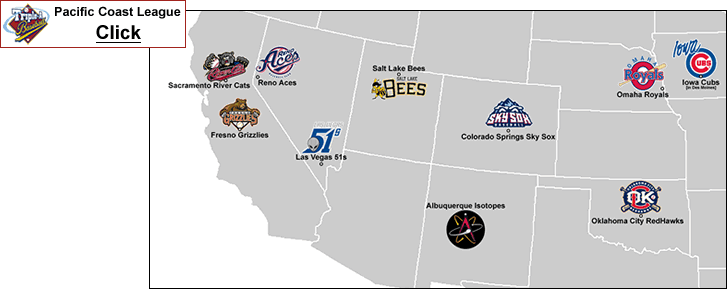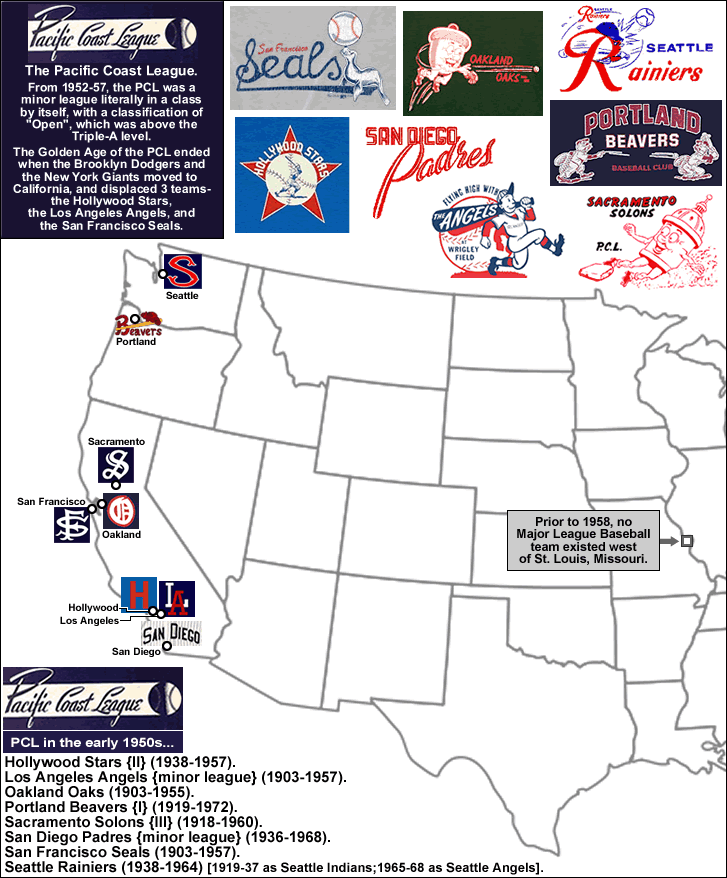Please note: A more recent map of the PCL (2016) is available, here:
Affiliated Triple-A minor league baseball (MiLB): location-map of 2 leagues, the Pacific Coast League (PCL) & the International League (IL) – with 2015 attendances and MLB-team-affiliations noted./ + illustrations for: the highest-drawing MiLB team in 2015, the Charlotte Knights & the 3rd-highest drawing team in MiLB in 2015, the Sacramento River Cats.
…
…
…
The Pacific Coast League, or PCL, is one of three Triple-A leagues in Major League Baseball’s minor league system [The other two Triple-A leagues are the eastern-USA-based International League, and the Mexican League.]. Triple-A is the highest designation in the minor league system. The Pacific Coast League was established in 1903. Since 1998, the PCL has been a 16-team league, and it now stretches from the Pacific Coast inland, all the way east to middle Tennessee.
-
In the first half of the 20th century, and up until the end of the 1957 season, the Pacific Coast League had a unique postion among minor league baseball leagues. This was because all the other minor leagues had teams which were in close proximity to major league ball clubs. But since there were no MLB clubs further west than St. Louis, Missouri until 1958, the PCL had no competition for fans. One could say because of this isolation, the PCL was sort of in a class by itself. And in fact, from 1952 to 1957, the PCL was given the “Open” classification, putting them a step above the Triple-A classification. This was part of the Pacific Coast League’s attempt to become the third major league, alongside the American League and the National League.
-
Seasons in the PCL could go from early February to December. In 1905, the San Francisco Seals played 230 games, and up until the mid-1950s, teams in the PCL were playing about 2 dozen more games (around 170-180 per season) than MLB teams.
Most PCL players were locally born, and wages were so competitive with other leagues, and even with the major leagues, that many skilled players chose to remain out west in the PCL, rather than sign with major league teams in the east. Of course, the PCL did produce some greats, indeed two of the all-time greatest ball players began here: Joe DiMaggio, with the San Francisco Seals, and Ted Williams, with the original, minor league San Diego Padres.
Below: The Pacific Coast League in the early 1950s…
The Los Angeles Angels, a charter member of the PCL dating back to 1903, played in the 21,000-capacity Wrigley Field (Los Angeles), from 1925 to 1957. Here is a page on the LA version of Wrigley Field, from the BallParkTour.com site… Wrigley Field (Los Angeles). The Los Angeles Angels were the flagship team and the second-most successful PCL team of the first 55 years of the league, winning 12 titles in that era (the San Francisco Seals won 14 titles in that era). The LA Angels’ big rivals were [the second incarnation of] the Hollywood Stars (1938-1957), who actually played right adjacent to Hollywood in the Fairfax district of Los Angeles, in the 13,000-capacity Gilmore Field (now the site of CBS Television City). True to their name, the ball club had movie stars as supporters, and even investors, of the team, and had the slogan “The Hollywood Stars owned by the Hollywood stars.” Star of Westerns Gene Autry was a principal owner, and the cinema superstar Gary Cooper was also a co-owner. Comedian and box-office topper Bob Hope was actively involved with the Stars, and in the link I have put in a couple of sentences on, you can see a photo of Hope hamming it up at Gilmore Field, alongside Gary Cooper.
However, being the third major league was not in the cards for the Pacific Coast League. The demise of train travel, and the rise of jet aircraft travel on a widespread basis circa the mid 1950s certainly led to the erosion of the PCL’s convenient isolation. But what really did in their preeminent status in the minor leagues was the arrival of two major league ball clubs. Basically, the Brooklyn Dodgers and the New York Giants, by moving to California in 1958, put an end to the Golden Age of PCL baseball. After the Dodgers displaced both the Los Angeles Angels and the Hollywood Stars; and the Giants displaced the San Francisco Seals, these three ball clubs were forced to relocate to smaller markets, and the clout that the league had disappeared, almost overnight, as its once captive markets had a higher calibre of baseball nearby to follow, and its three strongest franchises were neutered. The LA Angels moved north, to eastern Washington state, as the Spokane Indians. The SF Seals moved to Arizona, as the Phoenix Giants. And the Hollywood Stars moved to Utah, as the second incarnation of the Salt Lake Bees, before folding in 1965 (a third Salt Lake Bees has been in the present-day PCL since 1994). Boy, moving from the center-of-the-universe nirvana of 1950s Hollywood to the ascetic cultural landscape of Utah…you really know the party is over when that happens.
So the 1958 move west of the Dodgers and the Giants was not just a wrenching loss for the borough of Brooklyn and National League baseball fans in the New York City area, but it also spelt the end of a halcyon era in west coast baseball.
…
The modern-day PCL took on 5 Midwest ball clubs in the autumn of 1997, when the American Association (minor league) folded. The teams that joined the PCL from the AA, after the 1997 season were: the Iowa Cubs, the Nashville Sounds, the New Orleans Zephyrs, the Omaha Royals, and the Oklahoma [City] RedHawks. That winter, another city from the middle of the country was added to balance the league at an even amount of teams…the Memphis Redbirds. Also in 1998, the Fresno Grizzlies joined the league (with the franchise that left Phoenix after Phoenix got an MLB team).
Since then, the PCL has shed all 3 of its Canadian teams. First to go was Vancouver, who in 1999 moved to the capital city of California to become the Sacramento River Cats. The River Cats are currently the highest-drawing team in the PCL, and averaged 9,126 per game last year.
Then in 2003, the Calgary Cannons moved to Albuquerque, New Mexico (who had lost a PCL team 2 years earlier). The fans in Albuquerque voted for the team’s nickname, The Isotopes, which is a reference to the baseball team from fictional Springfield, in The Simpsons. The Isotopes draw third-best in the PCL, and averaged 8,363 in 2009.
The third and last Canadian PCL team to go was the Edmonton Trappers, in 2005. This team now plays near Austin, Texas as the Round Rock Express. Round Rock draws well, second-best currently in the PCL, pulling in 8,708 per game last season.
___
Thanks to the contributors to the pages at en.wikipedia.org…Pacific Coast League.
Thanks to Retro Brand (vintage wear) site, Retro Brand store.
Thanks to LogoServer, LogoServer, PCL logos.
Thanks to The Biz Of baseball site, for the attendance figures… Biz Of Baseball/Minor League Baseball Attendance Database.


